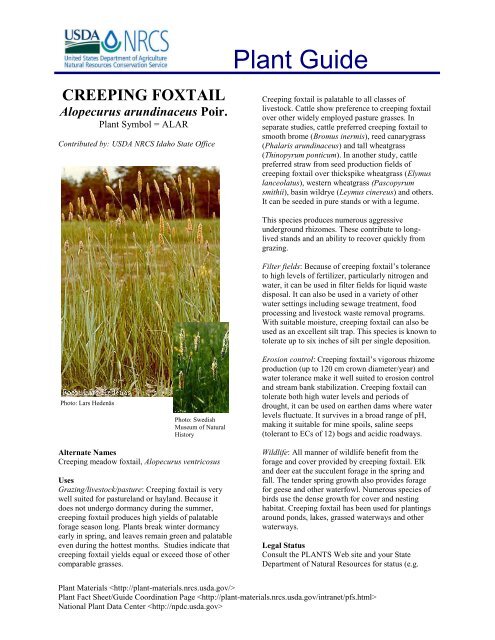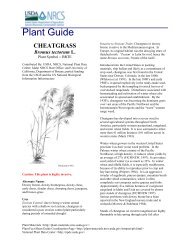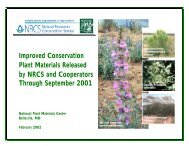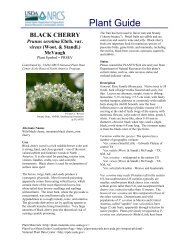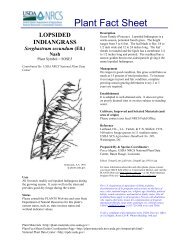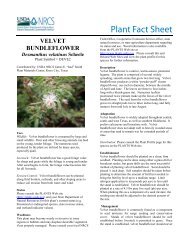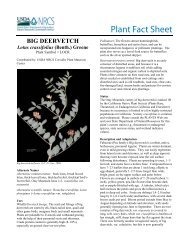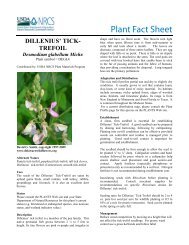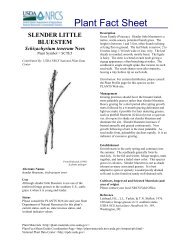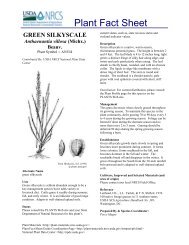CREEPING FOXTAIL - USDA Plants Database - US Department of ...
CREEPING FOXTAIL - USDA Plants Database - US Department of ...
CREEPING FOXTAIL - USDA Plants Database - US Department of ...
Create successful ePaper yourself
Turn your PDF publications into a flip-book with our unique Google optimized e-Paper software.
<strong>CREEPING</strong> <strong>FOXTAIL</strong><br />
Alopecurus arundinaceus Poir.<br />
Plant Symbol = ALAR<br />
Contributed by: <strong><strong>US</strong>DA</strong> NRCS Idaho State Office<br />
Photo: Lars Hedenäs<br />
Photo: Swedish<br />
Museum <strong>of</strong> Natural<br />
History<br />
Alternate Names<br />
Creeping meadow foxtail, Alopecurus ventricosus<br />
Uses<br />
Grazing/livestock/pasture: Creeping foxtail is very<br />
well suited for pastureland or hayland. Because it<br />
does not undergo dormancy during the summer,<br />
creeping foxtail produces high yields <strong>of</strong> palatable<br />
forage season long. <strong>Plants</strong> break winter dormancy<br />
early in spring, and leaves remain green and palatable<br />
even during the hottest months. Studies indicate that<br />
creeping foxtail yields equal or exceed those <strong>of</strong> other<br />
comparable grasses.<br />
Plant Guide<br />
Creeping foxtail is palatable to all classes <strong>of</strong><br />
livestock. Cattle show preference to creeping foxtail<br />
over other widely employed pasture grasses. In<br />
separate studies, cattle preferred creeping foxtail to<br />
smooth brome (Bromus inermis), reed canarygrass<br />
(Phalaris arundinaceus) and tall wheatgrass<br />
(Thinopyrum ponticum). In another study, cattle<br />
preferred straw from seed production fields <strong>of</strong><br />
creeping foxtail over thickspike wheatgrass (Elymus<br />
lanceolatus), western wheatgrass (Pascopyrum<br />
smithii), basin wildrye (Leymus cinereus) and others.<br />
It can be seeded in pure stands or with a legume.<br />
This species produces numerous aggressive<br />
underground rhizomes. These contribute to longlived<br />
stands and an ability to recover quickly from<br />
grazing.<br />
Filter fields: Because <strong>of</strong> creeping foxtail‟s tolerance<br />
to high levels <strong>of</strong> fertilizer, particularly nitrogen and<br />
water, it can be used in filter fields for liquid waste<br />
disposal. It can also be used in a variety <strong>of</strong> other<br />
water settings including sewage treatment, food<br />
processing and livestock waste removal programs.<br />
With suitable moisture, creeping foxtail can also be<br />
used as an excellent silt trap. This species is known to<br />
tolerate up to six inches <strong>of</strong> silt per single deposition.<br />
Erosion control: Creeping foxtail‟s vigorous rhizome<br />
production (up to 120 cm crown diameter/year) and<br />
water tolerance make it well suited to erosion control<br />
and stream bank stabilization. Creeping foxtail can<br />
tolerate both high water levels and periods <strong>of</strong><br />
drought, it can be used on earthen dams where water<br />
levels fluctuate. It survives in a broad range <strong>of</strong> pH,<br />
making it suitable for mine spoils, saline seeps<br />
(tolerant to ECs <strong>of</strong> 12) bogs and acidic roadways.<br />
Wildlife: All manner <strong>of</strong> wildlife benefit from the<br />
forage and cover provided by creeping foxtail. Elk<br />
and deer eat the succulent forage in the spring and<br />
fall. The tender spring growth also provides forage<br />
for geese and other waterfowl. Numerous species <strong>of</strong><br />
birds use the dense growth for cover and nesting<br />
habitat. Creeping foxtail has been used for plantings<br />
around ponds, lakes, grassed waterways and other<br />
waterways.<br />
Legal Status<br />
Consult the PLANTS Web site and your State<br />
<strong>Department</strong> <strong>of</strong> Natural Resources for status (e.g.<br />
Plant Materials <br />
Plant Fact Sheet/Guide Coordination Page <br />
National Plant Data Center
threatened or endangered species, state noxious<br />
status, and wetland indicator values).<br />
Weediness<br />
In addition to aggressive rhizomes, creeping foxtail<br />
proliferates by windborne and waterborne seeds.<br />
Rapid reproduction can be useful in repairing<br />
damaged sites; however, creeping foxtail‟s ability to<br />
spread quickly may create management problems in<br />
canals, irrigation ditches and other waterways.<br />
Please consult with your local NRCS Field Office,<br />
Cooperative Extension Service <strong>of</strong>fice, or state natural<br />
resource or agriculture department regarding this<br />
species‟ status and use. Weed information is also<br />
available from the PLANTS Web site.<br />
Description<br />
General: Grass Family (Poaceae). Creeping foxtail is<br />
a large, long-lived, rhizomatous, sod-forming,<br />
perennial grass introduced from Eurasia.<br />
Culms are tall (5 to 12 dm) and stout (~8 mm).<br />
Cauline leaves are numerous, flat and green, mostly 6<br />
to 8 mm (12), glabrous above and scabrous beneath.<br />
The membranous ligule is 1 to 5 mm long and is<br />
rounded to acute.<br />
The inflorescence is a spike-like, cylindrical panicle,<br />
typically 4 to 10 cm long and around 8 mm thick,<br />
turning purplish or black with maturity. It has a very<br />
similar appearance to the seedheads <strong>of</strong> timothy, but<br />
creeping foxtail heads turn the dark colors described<br />
above with maturity and Timothy seedheads turn a<br />
brownish – buff color.<br />
Individual spikelets are single flowered and urnshaped<br />
(4 to 5 mm long, 1 to 1.5 mm wide). The<br />
glumes are fused basally and are strongly keeled with<br />
a ciliate margin, the hairs 1 to 2 mm. Lemmas are<br />
typically shorter than the glumes and may bear a<br />
straight to geniculate awn (1 to 2 mm) arising from<br />
below to slightly above mid-length. Anthers are<br />
usually purple but are occasionally yellow or orange.<br />
Anthesis occurs early in the season. Seed maturation<br />
begins at the top <strong>of</strong> the inflorescence and proceeds<br />
downward. Spikelets disarticulate below the glumes<br />
with the spikelet falling as a single unit.<br />
Creeping foxtail should not be confused with other<br />
grass species that share the common name foxtail.<br />
Creeping foxtail is a close relative <strong>of</strong> meadow foxtail<br />
(Alopecurus pratensis) and can be distinguished by<br />
having broader leaves (8-12 mm vs. 4-8 mm) and a<br />
dark purplish inflorescence. There are also many<br />
weedy species that bear the name foxtail, i.e. foxtail<br />
barley (Hordeum jubatum) and green foxtail (Setaria<br />
viridis). These may occupy the same habitats as<br />
creeping foxtail, but bear little or no resemblance.<br />
Distribution: This species is native to the colder<br />
regions <strong>of</strong> Europe and Asia. It ranges naturally from<br />
the British Isles in the west to Siberia in the east<br />
going as far south as Turkey and Italy and possibly<br />
China.<br />
Records indicate that creeping foxtail was introduced<br />
into the United States around the end <strong>of</strong> the 19 th<br />
century. At the time, it was little used by farmers<br />
who lacked the specialized equipment to plant and<br />
harvest its small fluffy seeds. With the advent <strong>of</strong><br />
more advanced machinery in the 1930‟s and 40‟s, it<br />
became more widely used in forage practices.<br />
Presently, it is most commonly utilized throughout<br />
the Pacific Northwest, Intermountain West, Northern<br />
Great Plain States and western Canada. It is<br />
projected that creeping foxtail could be used as far<br />
east as the New England states.<br />
For more information on distribution, please consult<br />
the plant pr<strong>of</strong>ile page for this species on the PLANTS<br />
Website.<br />
Adaptation<br />
Creeping foxtail is adapted to cold temperatures and<br />
wet conditions. It is extremely winter hardy. It can<br />
establish and survive in areas where frost-free periods<br />
average less than 30 days annually. Studies indicate<br />
creeping foxtail outperforms smooth brome on<br />
flooded permafrost soils in Alaska. It also grows<br />
well at a broad range <strong>of</strong> elevations (500-9000 ft), but<br />
grows best on middle to high elevation wet to semiwet<br />
sites.<br />
This species is well adapted to areas <strong>of</strong> high moisture<br />
typically too wet for good production <strong>of</strong> most forage<br />
grasses, i.e. brome (Bromus species) and<br />
orchardgrass (Dactylis glomerata) and is a superior<br />
forage to other semi-wetland grasses, such as tall<br />
fescue and other wetland grasses, such as reed<br />
canarygrass, meadow foxtail and timothy. It usually<br />
occurs in areas receiving more than 18 inches <strong>of</strong><br />
precipitation. It also grows readily along margins <strong>of</strong><br />
ponds, lakes, bogs, ditches and in mountain<br />
meadows. It can withstand periodic flooding <strong>of</strong> 60 to<br />
90 cm for up to 45 days. Some varieties are also<br />
somewhat drought tolerant, being able to survive in<br />
areas with widely fluctuating water levels and<br />
drought during later summer periods.
Creeping foxtail does well in a broad spectrum <strong>of</strong><br />
soils provided there is sufficient available water. It<br />
can grow in sand, clay, peat and muck. It is<br />
moderately salt tolerant (up to 12 millimhos/cm) and<br />
tolerates both moderately acidic soils (pH 5.6 to 6.0)<br />
and slightly alkaline soils (pH 7.9 to 8.4).<br />
Establishment<br />
Creeping foxtail establishment techniques are similar<br />
to those for other forage grasses. For best results the<br />
seedbed should be weed free, moist and firmly<br />
packed. Follow seeding with a light harrowing or<br />
packing operation. Optimum seeding depth is 1/8 to<br />
1/4 inch and no deeper than ½ inch.<br />
Timing depends almost entirely on available<br />
moisture. Irrigated fields can be seeded in early to<br />
mid spring or late summer avoiding the hot mid<br />
summer period. Irrigated fall seedings can be<br />
successful as late as early to mid-September allowing<br />
for enough time (6 to 8 weeks) for seedling<br />
establishment before freezing temperatures. Where<br />
precipitation is required, seed when soil is moist but<br />
firm enough or frozen to support seeding equipment.<br />
Late fall dormant seedings (after October 20 th in most<br />
areas), winter and very early spring seedings are most<br />
effective under non-irrigated conditions where seeds<br />
are not allowed to germinate until spring.<br />
This species produces very light seed units (750,000<br />
seeds/lb) which allow for low relative seeding rates<br />
for adequate stand establishment. It is recommended<br />
that a minimum seeding rate <strong>of</strong> 3 to 4 lb/acre is used<br />
for ease <strong>of</strong> handling and uniform distribution through<br />
seeding equipment . This rate provides 51 to 68<br />
seed/ft 2 .<br />
It is popular to dilute the seed with inert materials,<br />
i.e. rice hulls, cracked corn or other cracked grains.<br />
For rice hulls, cracked wheat or cracked barley, dilute<br />
3-4 lb/acre seed with 2 bushel/acre dilutor, and set<br />
the drill to seed the equivalent <strong>of</strong> 2 bushels <strong>of</strong> barley<br />
per acre. For cracked corn reduce dilutor to 1 bushel/<br />
acre.<br />
When seeding with a legume, it is recommended that<br />
one plant in alternate rows. Studies conducted with<br />
„Lutana‟ cicer milkvetch (Astragalus cicer) and<br />
„Eski‟ sainfoin (Onobrychis viciaefolia) showed<br />
increases in yield over a four-year period when<br />
planted in alternate rows.<br />
Management<br />
Young seedlings are small and weak. Growth is slow<br />
for the first 4 to 6 weeks even under irrigated<br />
conditions. Rhizomes can emerge as early as 8<br />
weeks. With the emergence <strong>of</strong> rhizomes, growth is<br />
rapid. With adequate soil moisture inflorescences<br />
may develop in mid to late summer, but first year<br />
plants typically do not produce seedheads, or when<br />
they do, there is not enough seed for a pr<strong>of</strong>itable<br />
harvest.<br />
Under non-irrigated conditions, it is not uncommon<br />
to have difficulty determining stand establishment the<br />
first growing season. Stand success should not be<br />
determined until the second or third growing season<br />
under non-irrigated conditions.<br />
Applications <strong>of</strong> commercial fertilizer are not required<br />
during the establishment period; however, creeping<br />
foxtail responds very favorably to applications <strong>of</strong> 50<br />
to 60 lb/acre actual nitrogen once established.<br />
Creeping foxtail plants show little response to<br />
applications <strong>of</strong> potassium, phosphates and secondary<br />
elements.<br />
When planted with a legume, adjust fertilizer rates<br />
according to desires: For more grass production<br />
increase nitrogen, for more legume production<br />
increase phosphorus and potassium.<br />
Weeds can be controlled using standard herbicide<br />
practices, although weeds should cause few problems<br />
with adequate fertilizer.<br />
Pests and Potential Problems<br />
Creeping foxtail has historically shown little damage<br />
from insects and other diseases; however, in some<br />
years leaf spot diseases have been recorded as a<br />
problem in Canada.<br />
Seed and Plant Production<br />
Seed production practices for creeping foxtail are<br />
more involved and difficult than those <strong>of</strong> most other<br />
forage grasses. Harvest timing is critical for a good<br />
yield, and seed cleaning requires more time and<br />
equipment than for most other grass species.<br />
Stands should be planted in wide-spaced 36 to 48<br />
inch rows, but rhizomes cause sod binding and row<br />
closing. This can be overcome by applying high<br />
levels <strong>of</strong> nitrogen and aggressive cultivation to<br />
maintain desired row culture.<br />
During establishment, apply enough phosphorus for<br />
three years according to forage production rate. No<br />
nitrogen should be added until seedlings are<br />
established, or drill 50 lb/acre <strong>of</strong> 11-48-0 with the<br />
seed. Once seedlings are established apply 30 lb/acre<br />
N for dryland or 60 to 80 lb/acre N for irrigated<br />
fields.
Nitrogen application in the fall on established fields<br />
positively influences inflorescence size and number.<br />
Apply 100 to 150 lb/acre N each year. Studies have<br />
shown inflorescence production rose as nitrogen<br />
levels were increased up to 100 lb/acre actual N.<br />
After 150 lb/acre production tapered <strong>of</strong>f as plants<br />
used more nitrogen for foliage than seed production.<br />
Seed yields with 100 lb/acre were as high as 570<br />
lb/acre while yields <strong>of</strong> 350 lb/acre were achieved<br />
when no nitrogen was applied.<br />
During establishment, enough water should be<br />
applied to get stands started. The soil surface should<br />
be kept moist to avoid crusting. In early September<br />
bring soil moisture up to field capacity. Established<br />
fields should be irrigated in spring through the boot<br />
stage. Soil moisture should be kept above 50% field<br />
capacity. Good soil moisture is necessary during the<br />
early phase <strong>of</strong> seed development to prevent moisture<br />
stress, but do not irrigate during flowering or seed<br />
ripening. After harvest irrigate to field capacity to<br />
promote vegetative production.<br />
Since seed maturation is temperature dependent,<br />
different regions will be harvested at different times<br />
<strong>of</strong> year. For proper timing <strong>of</strong> harvest, attention must<br />
be paid to three indicators. (1) 75 percent or more <strong>of</strong><br />
the seeds should be black. (2) 50 percent <strong>of</strong> the<br />
inflorescences have begun to shatter at the tip. (3) 75<br />
percent <strong>of</strong> the stems are yellow up to 3 to 4 inches<br />
directly below the inflorescence. These three events<br />
<strong>of</strong>ten occur quickly over a three day period.<br />
<strong>Plants</strong> are typically windrowed, dried (3 to 5 days)<br />
and picked up by a combine. Seed heads shatter<br />
readily. Hand harvested seeds yielded over 500<br />
lb/acre while machine harvested fields yielded as<br />
little as 180 lb/acre. It is recommended that you slow<br />
the reel speed <strong>of</strong> both the windrower and combine to<br />
equal to or slightly higher than ground speed. It is<br />
also recommended to make these adjustments to the<br />
combine: (1) slow ground speed to allow more<br />
separating time; (2) shut <strong>of</strong>f air flow by sealing the<br />
fan housing or inactivating the fan; (3) remove<br />
screens following the sieves; (4) adjust concave<br />
spacing to ¼ inch; (5) adjust cylinder speed to<br />
approximately 3500 ft/min. (750 to 850 rpm).<br />
An alternative harvesting method employed by the<br />
NRCS Bismarck Plant Materials Center and others is<br />
the use <strong>of</strong> a seed stripper. For best results ground<br />
speed should be 1.5 to 2 mph. Tachometer speed can<br />
be from 1100 to 1800 rpm, and the brush speed<br />
should be around 425 rpm.<br />
Typical production is 300 pounds per acre irrigated<br />
and 150 pounds per acre non-irrigated. Non-irrigated<br />
seed production is not recommended below 16 inches<br />
<strong>of</strong> annual precipitation.<br />
Seeds should be dried prior to storage at temperatures<br />
not over 104º F (40º C). Store seed in bins at 12%<br />
moisture content or sacks (15%).<br />
A barley debearder can be used to remove the fine<br />
hairs from the glume keels and to remove stems and<br />
chaff. The debearder should be run at 500 rpm long<br />
enough to break down stems. Seeds can then be<br />
cleaned using a #9 round hole in the top screen, 1/18”<br />
x ¼” slotted middle screen and a 6 x 36 wire mesh<br />
bottom screen. The fan should be set to a slow, light<br />
wind speed (100 to 150 rpm).<br />
Cultivars, Improved and Selected Materials (and<br />
area <strong>of</strong> origin)<br />
Foundation seed is available through the appropriate<br />
state Crop Improvement Association or commercial<br />
sources to grow certified seed.<br />
‘Garrison’ creeping foxtail (Alopecurus<br />
arundinaceus) was named and released by the<br />
Natural Resources Conservation Service Plant<br />
Materials Center in Bismarck, North Dakota in 1963.<br />
The original collection was made in 1950 near Max,<br />
North Dakota where plants were growing on the<br />
margins <strong>of</strong> potholes. „Garrison‟ is adapted to cold<br />
temperature regions where there is abundant water. It<br />
is especially well suited to higher elevation areas that<br />
receive 18 inches or more precipitation annually or<br />
along the margins <strong>of</strong> ponds, lakes, ditches and other<br />
waterways. It provides excellent forage for cattle and<br />
other classes <strong>of</strong> livestock by producing highly<br />
palatable leaves throughout the growing season.<br />
„Garrison‟ has a high moisture tolerance and<br />
produces vigorous rhizomes making it an excellent<br />
choice for controlling streambank and shoreline<br />
erosion. Certified seed is available.<br />
Breeder and Foundation seed is maintained by the<br />
Bridger, Montana PMC.<br />
‘Retain’ creeping foxtail (Alopecurus arundinaceus)<br />
was selected by the South Dakota Agricultural<br />
Experiment Station and released in 1979. This is a<br />
five-clone synthetic single plant selection from<br />
„Garrison.‟ „Retain‟ is very similar to „Garrison,‟ but<br />
this cultivar retains seed on the panicle making it<br />
possible to harvest with a direct cut combine. Like<br />
„Garrison,‟ it is well adapted to wet areas and is flood<br />
tolerant. It is highly palatable to livestock. It<br />
matures early, heading in mid-May.
Breeder and foundation seed are maintained by South<br />
Dakota State University. Contact for availability.<br />
Control<br />
Contact your local agricultural extension specialist or<br />
county weed specialist to determine the best control<br />
methods in your area and how to use it safely.<br />
References<br />
Alderson, J. & W. C. Sharp 1994. Grass varieties in<br />
the United States. Agriculture Handbook No. 170.<br />
<strong><strong>US</strong>DA</strong>, SCS, Washington, DC.<br />
Cornforth, B. L. St. John & D. G. Ogle. 2001. Seed<br />
production standards for conservation plants in the<br />
intermountain west. <strong><strong>US</strong>DA</strong>-NRCS, Boise, ID. ID-TN<br />
14, Dec. 2001. 15p.<br />
Hitchcock, A. S. 1935. Manual <strong>of</strong> the grasses <strong>of</strong> the<br />
United States. <strong><strong>US</strong>DA</strong>, Washington DC.<br />
Ogle, D. G. 1994. Technical Note 9: Salt tolerance <strong>of</strong><br />
plants. <strong><strong>US</strong>DA</strong>-NRCS, Boise, ID. ID-TN 9, Oct.<br />
1994. 6p.<br />
Ogle, D. G., L. St. John, M. Stannard & L.<br />
Holzworth. 2003. Technical Note 24: Grass, grasslike,<br />
forb, legume, and woody species for the<br />
intermountain west. <strong><strong>US</strong>DA</strong>-NRCS, Boise, ID. ID-TN<br />
24, Jan. 2003. 41p.<br />
Smith, R., D. Cattani, D. Feindel, R. Haas, D. Tober,<br />
L. Holzworth, M. Majerus, D. Hall & K. Borcher.<br />
Native Grass Seed Production Manual (Including<br />
Selected Forbs). <strong><strong>US</strong>DA</strong>-NRCS, Ducks Unlimited<br />
Canada, the Manitoba Forage Seed Association and<br />
the University <strong>of</strong> Manitoba.<br />
<strong><strong>US</strong>DA</strong>, Soil Conservation Service 1978. „Garrison’<br />
Creeping Foxtail. SCS-TP-156.<br />
<strong><strong>US</strong>DA</strong>, Soil Conservation Service. 1990. Technical<br />
Note 7: Grass-legume-forb seed dilution with rice<br />
hulls. <strong><strong>US</strong>DA</strong>-SCS, Boise, ID. ID-TN 7, Oct. 1990.<br />
5p.<br />
<strong><strong>US</strong>DA</strong>, NRCS. 2004. The PLANTS <strong>Database</strong>,<br />
Version 3.5 (http://plants.usda.gov). National Plant<br />
Data Center, Baton Rouge, LA 70874-4490 <strong>US</strong>A.<br />
Welsh, S. L., N. D. Atwood, S. Goodrich & L. C.<br />
Higgins. 1993. A Utah Flora. Brigham Young<br />
University Press, Provo, Utah.<br />
Images courtesy <strong>of</strong> “Den Virtuella Floran” used by<br />
permission <strong>of</strong> the Swedish Museum <strong>of</strong> Natural<br />
History.<br />
Prepared By:<br />
Derek J. Tilley, Range Conservationist (<strong>Plants</strong>)<br />
<strong><strong>US</strong>DA</strong> NRCS Plant Materials Center, Aberdeen,<br />
Idaho<br />
Dan Ogle, Plant Materials Specialist<br />
<strong><strong>US</strong>DA</strong> NRCS Idaho State Office, Boise, Idaho<br />
Loren St. John, Manager<br />
<strong><strong>US</strong>DA</strong> NRCS Plant Materials Center, Aberdeen,<br />
Idaho<br />
Wayne Duckwitz, Manager<br />
<strong><strong>US</strong>DA</strong> NRCS Plant Materials Center, Bismarck,<br />
North Dakota<br />
Larry Holzworth, Plant Materials Specialist<br />
<strong><strong>US</strong>DA</strong> NRCS Montana State Office, Bozeman,<br />
Montana<br />
Mark Majerus, Manager<br />
<strong><strong>US</strong>DA</strong> NRCS Plant Materials Center, Bridger,<br />
Montana<br />
Dwight Tober, Plant Materials Specialist<br />
<strong><strong>US</strong>DA</strong> NRCS North Dakota State Office, Bismarck,<br />
North Dakota<br />
Species Coordinator:<br />
Larry Holzworth, Plant Materials Specialist<br />
<strong><strong>US</strong>DA</strong>-NRCS, Montana State Office, Bozeman,<br />
Montana<br />
Edited: 03Mar04 djt; 31Mar04 dgo; 7Apr04 lkh; 7Apr04 dat;<br />
7Apr04 wld; 7Apr04 mem; 30may06jsp<br />
For more information about this and other plants, please contact<br />
your local NRCS field <strong>of</strong>fice or Conservation District, and visit the<br />
PLANTS Web site or the Plant Materials<br />
Program Web site <br />
The U.S. <strong>Department</strong> <strong>of</strong> Agriculture (<strong><strong>US</strong>DA</strong>) prohibits<br />
discrimination in all its programs and activities on the basis <strong>of</strong><br />
race, color, national origin, sex, religion, age, disability, political<br />
beliefs, sexual orientation, and marital or family status. (Not all<br />
prohibited bases apply to all programs.) Persons with disabilities<br />
who require alternative means for communication <strong>of</strong> program<br />
information (Braille, large print, audiotape, etc.) should contact<br />
<strong><strong>US</strong>DA</strong>'s TARGET Center at 202-720-2600 (voice and TDD).<br />
To file a complaint <strong>of</strong> discrimination write <strong><strong>US</strong>DA</strong>, Director, Office<br />
<strong>of</strong> Civil Rights, Room 326-W, Whitten Building, 14th and<br />
Independence Avenue, SW, Washington, DC 20250-9410 or call
202-720-5964 (voice or TDD). <strong><strong>US</strong>DA</strong> is an equal opportunity<br />
provider and employer.<br />
Read about Civil Rights at the Natural Resources Convervation<br />
Service.


